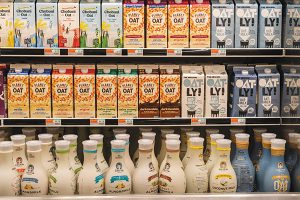Bloomberg
Plant milk is on the cusp of another boom as the industry courts a huge demographic it has ignored so far: children.
Using colourful bottles of oat and pea milk packed with protein and prebiotics, the category is winning over parents. At Ripple Foods, a startup that has raised more than $200 million, its plant-based option for kids has more calcium and vitamin D than cows’ milk. Sales of the offering have more than doubled expectations since launching in 2021, and distribution is increasing by more than 10,000 locations this year, including its debut in Kroger, America’s largest grocery chain.
Milk alternatives have swept through the US in recent years, approaching 20% of the market and $4 billion in sales. Yet that growth came largely from adults adding them to coffee and smoothies. Now the industry is turning to children — easily America’s biggest milk drinkers — in a looming threat to a dairy industry that has seen consumption decline for decades.
“When it came to the heaviest consumers in the category, no one was designing a product for them,†said Ripple Foods Chief Executive Officer Laura Flanagan, 53, who greenlit the creation of a kids offering shortly after joining the Berkeley, California-based company in 2019. “It was hugely exciting to uncover this unmet need.â€
The opportunity is significant with kids traditionally consuming about twice as much milk as adults, but the US dairy industry is also entrenched. A glass of milk has symbolised childhood for generations. Iconic campaigns like “Got Milk†and its milk mustache hardened the idea that being a good parent meant giving it to your offspring to help them grow strong with all its calcium and protein.
But the success of products like Ripple’s are showing how much today’s kids and their millennial parents have changed. Thanks to the popularity of brands like Oatly, about 60% of US households are buying alternative milk, according to data from researcher Mintel Group. Dairy allergies have also been rising in young children. Sales of imitations rose 15% last year and are on track to nearly double to $6.3 billion by 2026.
 The Gulf Time Newspaper One of the finest business newspapers in the UAE brought to you by our professional writers and editors.
The Gulf Time Newspaper One of the finest business newspapers in the UAE brought to you by our professional writers and editors.
